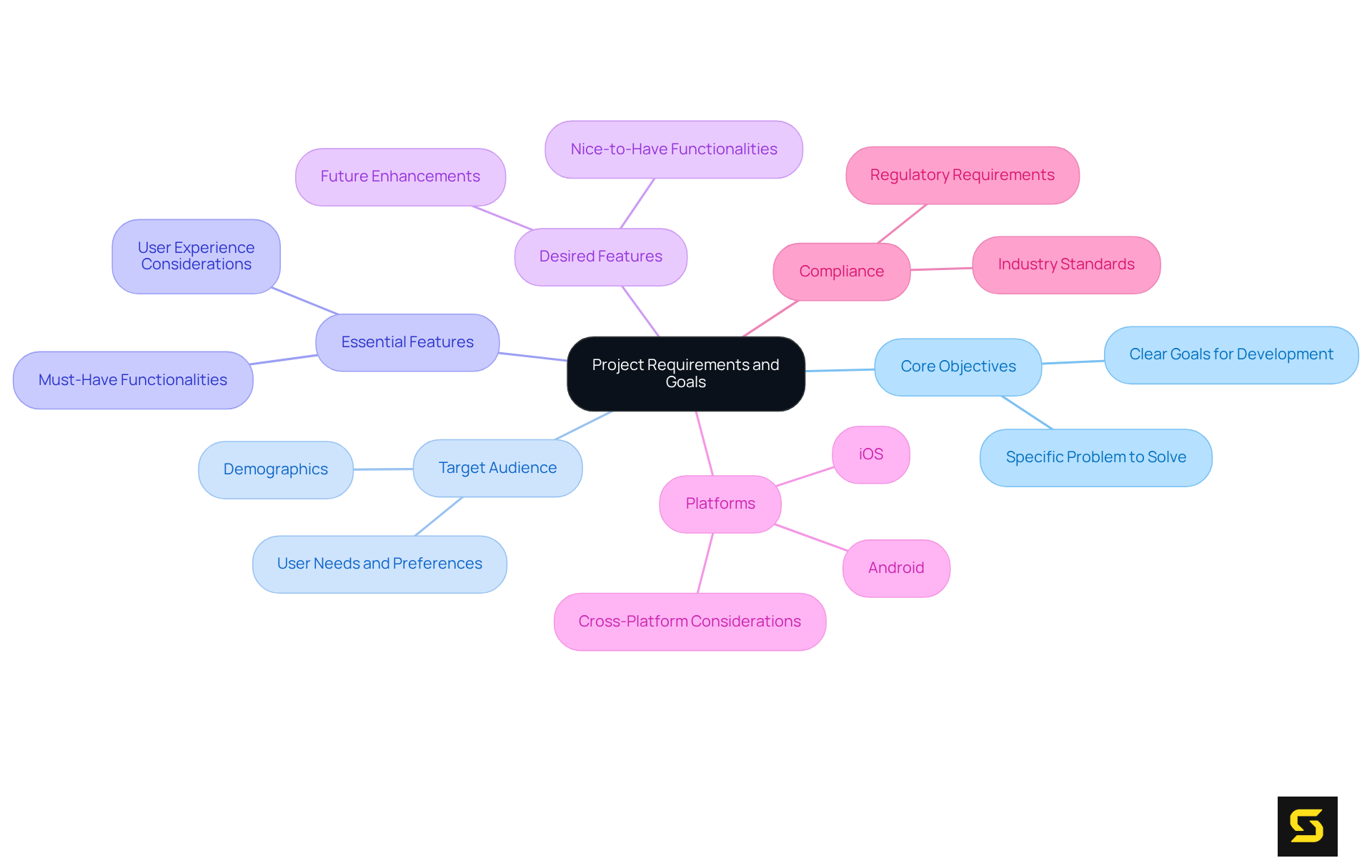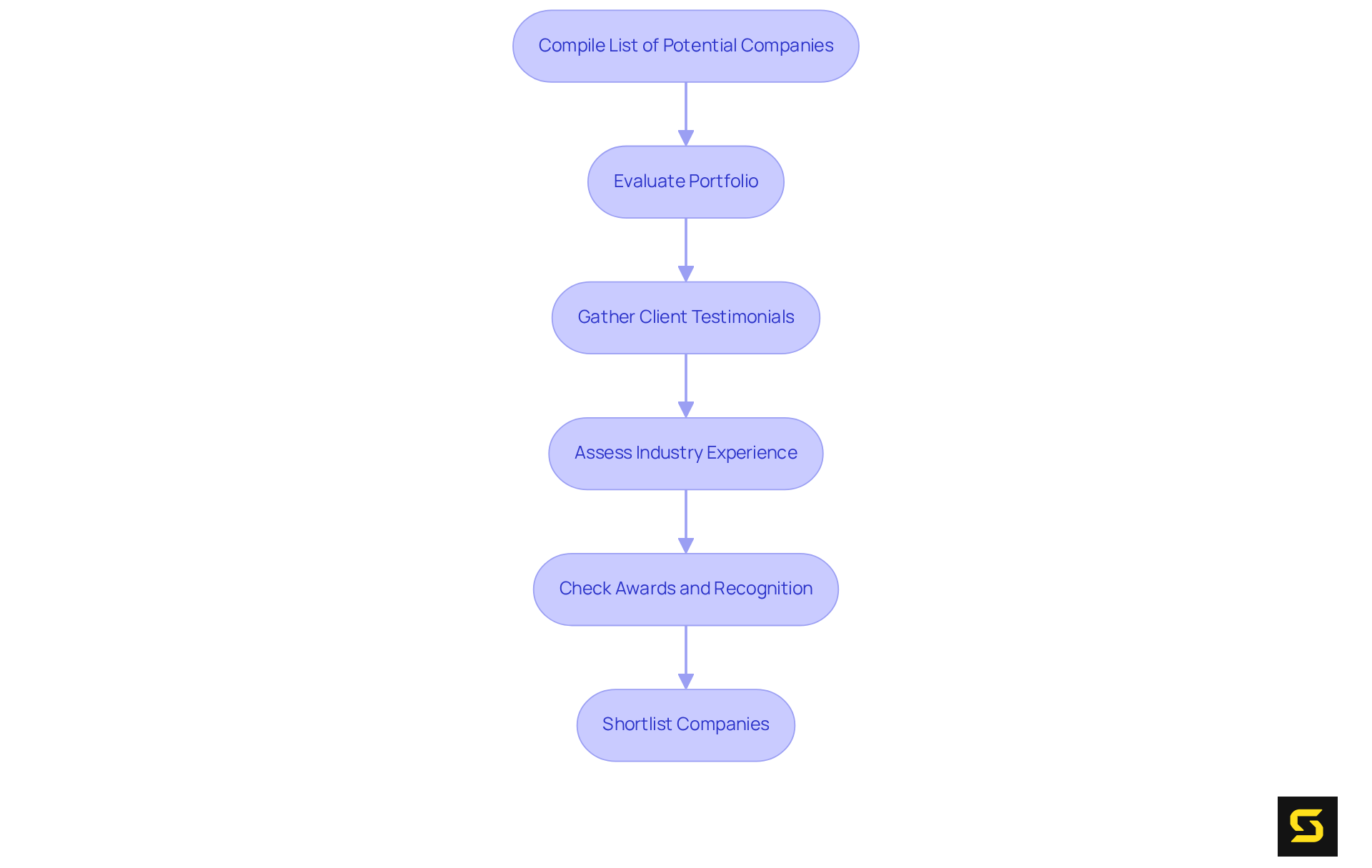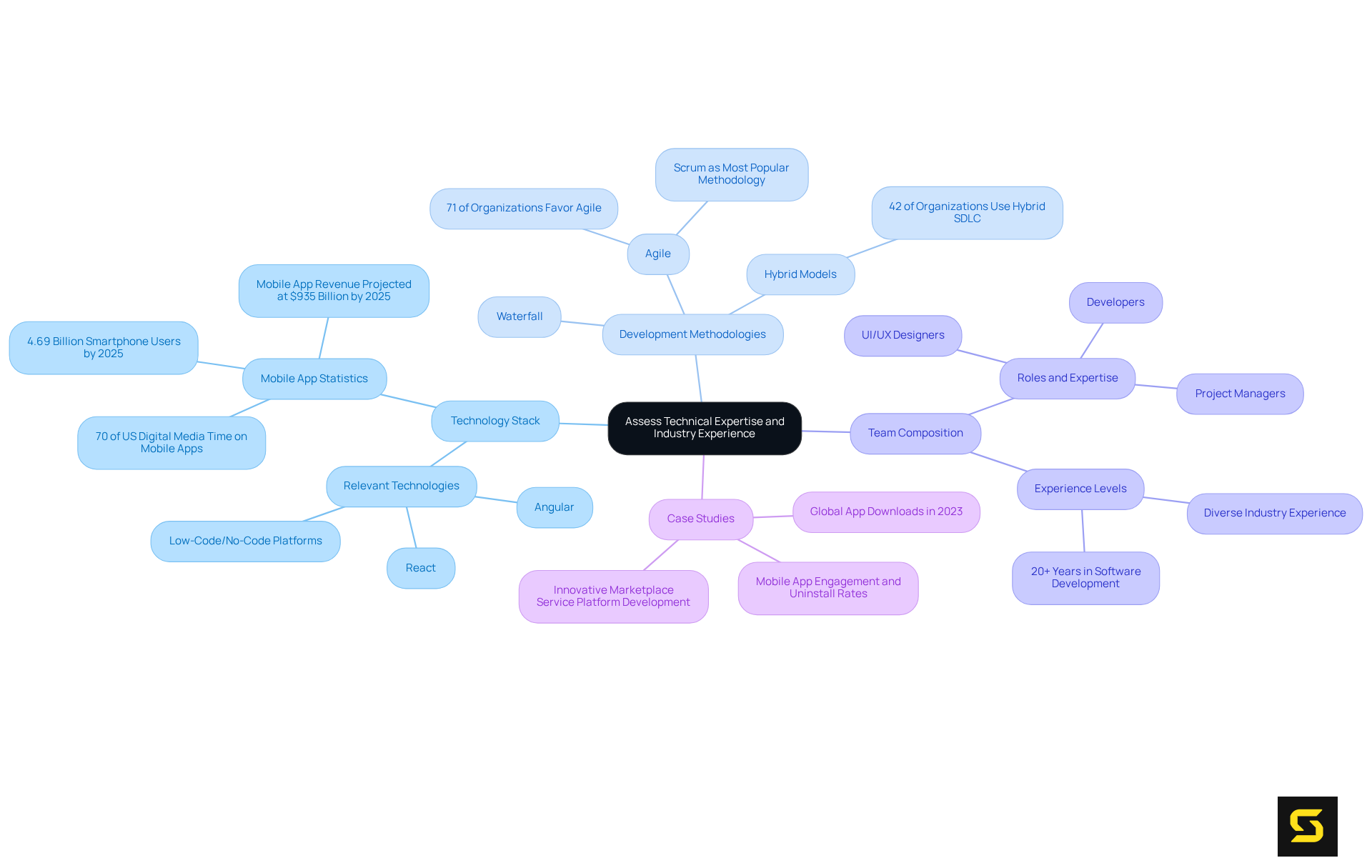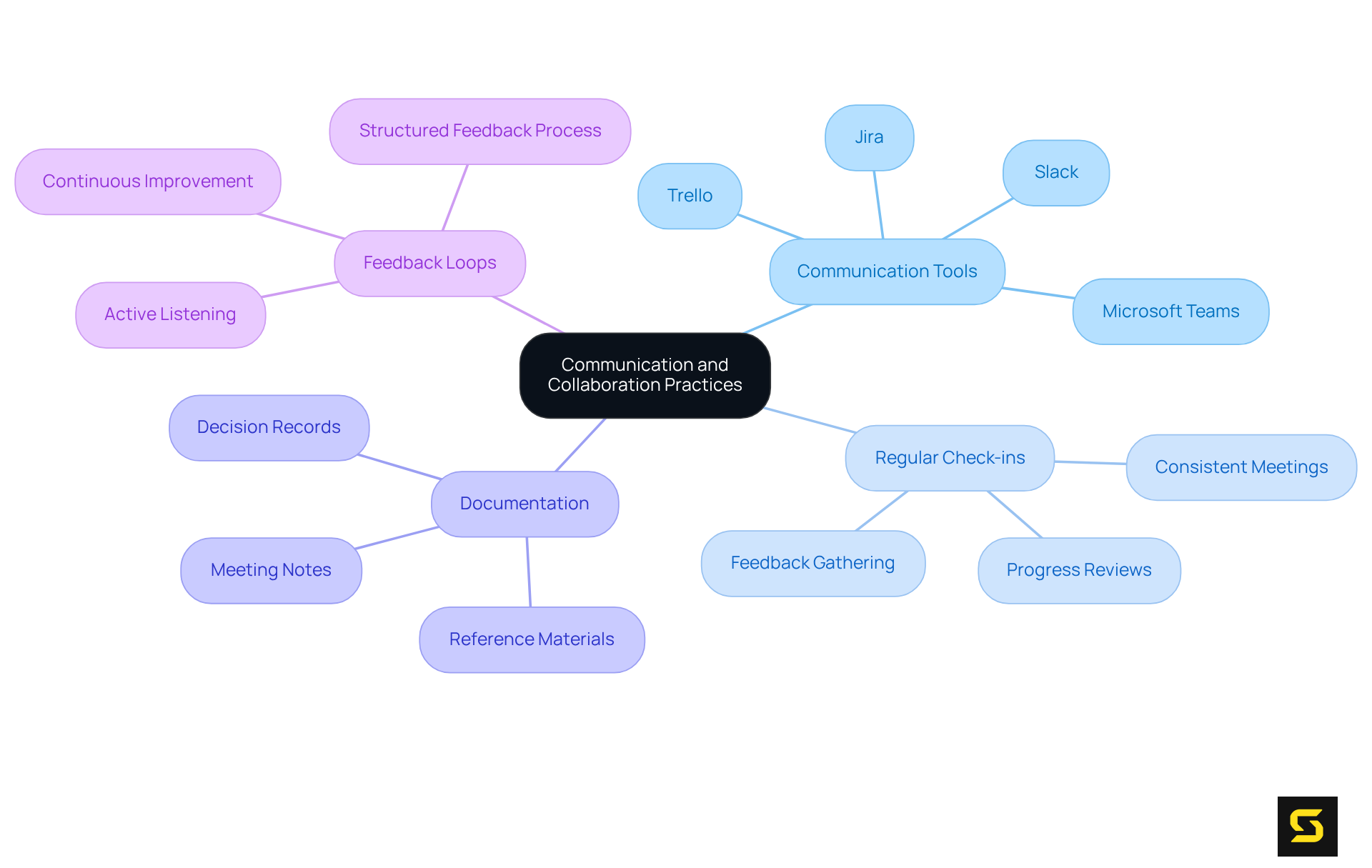Overview
To select the ideal mobile software development company, it is imperative to start by precisely defining your project requirements and goals. This includes:
- Identifying your target audience
- Determining the necessary features
A structured approach to articulating these objectives is essential. Thoroughly evaluating potential companies based on:
- Their portfolio
- Client testimonials
- Technical expertise
is crucial for ensuring successful app development that aligns with user needs. By taking these steps, you not only enhance your chances of success but also establish a foundation for a productive partnership.
Introduction
Navigating the landscape of mobile software development presents significant challenges, particularly as the industry evolves and expands. With the global mobile app market projected to reach an astounding $756 billion by 2027, selecting the right development partner is paramount. This article explores the essential steps for identifying a mobile software development company that aligns with your specific project goals and requirements.
How can businesses ensure they choose a firm that not only meets their technical needs but also fosters effective communication and collaboration throughout the development process?
Identify Your Project Requirements and Goals
Begin by distinctly defining the core objectives of your application. Consider the following critical questions:
- What specific problem does the app aim to solve?
- Who constitutes the target audience?
- Which features are essential, and which are merely desirable?
Creating a prioritized list of functionalities and design elements will provide clarity and direction. This organized approach not only fosters effective communication with potential collaborators but also ensures they grasp your vision accurately. Additionally, assess the platforms you wish to target—whether iOS, Android, or both—and identify any compliance or regulatory requirements relevant to your industry.
Industry leaders emphasize that outlining goals is vital to successful mobile app initiatives. As Allison Dunn aptly stated, "Mobile isn’t a tool you add at the end. It’s a foundation you build from the beginning." This perspective highlights the necessity of establishing clear objectives to steer the development process. Furthermore, statistics reveal that 71% of app removals stem from crashes and bugs, underscoring the critical need for well-defined goals and thorough testing.
Successful applications frequently emerge from precisely articulated project objectives and a deep understanding of the target audience. For instance, Domino's Pizza enhanced its ordering experience on smartphones, leading to over 60% of their orders being placed through these devices. By aligning your goals with user needs, you can significantly enhance engagement and retention, ultimately resulting in a more impactful product.

Research and Evaluate Potential Development Companies
Begin by compiling a comprehensive list of potential mobile software development companies. Leverage online directories, industry forums, and peer recommendations to gather viable options. Assess each company using the following criteria:
- Portfolio: Scrutinize their previous projects to evaluate the quality and relevance of their work. Look for a variety of app types and functionalities that resonate with your vision.
- Client Testimonials: Gather feedback from former clients to assess satisfaction levels and the company's capability to meet expectations. Positive testimonials often signify reliability and effectiveness.
- Industry Experience: Confirm that the company possesses experience in your specific sector, as this can greatly enhance their understanding of your unique needs and challenges.
- Awards and Recognition: Investigate any accolades or certifications that underscore their expertise and commitment to quality in app development.
In the competitive landscape where the global mobile app market is projected to reach $756 billion by 2027, partnering with the right mobile software development company is crucial. As Hiren Kalariya articulates, "User experience, performance, regular updates, value delivery, and retention strategies like push notifications and rewards are key to long-term success." After conducting a thorough evaluation, compile a shortlist of companies that excel in these areas, positioning yourself to make an informed decision. Furthermore, consider the significance of app performance, as illustrated in case studies, which can profoundly affect user retention and satisfaction. Organizations frequently grapple with the complexities of software development ventures amid economic uncertainties, underscoring the necessity of approaching this process with confidence.

Assess Technical Expertise and Industry Experience
After narrowing down your options, it is crucial to evaluate each company's technical expertise meticulously. Focus on these key areas:
- Technology Stack: Confirm their proficiency in technologies relevant to your project, such as React or Angular. A robust technology stack is vital for developing scalable applications, especially considering that 70% of all US digital media time is spent on mobile apps.
- Development Methodologies: Investigate their approach to progress—whether they utilize Agile, Waterfall, or hybrid models. Agile methodologies, favored by 71% of organizations, promote adaptability and rapid iteration, making them ideal for dynamic projects.
- Team Composition: Understand the structure of their development team, including the roles and expertise of its members. A well-rounded team can significantly enhance outcomes.
- Case Studies: Request case studies that illustrate their problem-solving capabilities and successful implementations within your industry. For example, the "Innovative Marketplace Service Platform Development" showcases how addressing user needs can lead to successful results. Such examples provide valuable insights into their experience and effectiveness.
This comprehensive assessment will empower you to determine whether the company possesses the essential skills and experience to transform your vision into reality.

Establish Communication and Collaboration Practices
After selecting a development firm, establishing clear communication protocols is essential for success. Effective communication is not just a practice; it is a cornerstone of project achievement. Consider the following practices:
-
Communication Tools: Select robust tools for daily interactions, such as Slack or Microsoft Teams, complemented by project management platforms like Trello or Jira. These tools must facilitate collaboration across distances, ensuring seamless communication and task tracking, which is crucial for remote teams.
-
Regular Check-ins: Schedule consistent meetings to review progress, tackle challenges, and gather feedback. Regular check-ins not only sustain momentum but also foster connections among team members. Research shows that 80% of employees believe enhanced communication could improve their work relationships, while 84% indicate that workplace challenges could persist for days, easily resolved through in-person discussions. This highlights the critical nature of these interactions.
-
Documentation: Ensure meticulous documentation of all discussions and decisions. This practice provides a valuable reference for future conversations and helps maintain clarity throughout the development process.
-
Feedback Loops: Establish a structured process for both giving and receiving feedback. This ongoing improvement system is vital for adapting to challenges and elevating the overall quality of the initiative. Incorporating active listening during meetings can enhance information retention and reduce errors, further strengthening the feedback mechanism.
Implementing these practices fosters a collaborative environment that significantly enhances project success rates, especially within a mobile software development company. By prioritizing effective communication and investing in soft skills, teams can navigate challenges more adeptly, leading to innovative solutions and superior outcomes.

Conclusion
Choosing the right mobile software development company is a pivotal step that can significantly influence the success of an app project. Establishing clear project requirements and goals creates a solid foundation that guides the development process. This foundational clarity enhances communication with potential partners and aligns the final product with user needs, ultimately driving engagement and retention.
Critical strategies have been highlighted, including:
- The importance of researching and evaluating potential development firms
- Assessing their technical expertise
- Establishing effective communication practices
By meticulously analyzing portfolios, client testimonials, and industry experience, as well as implementing structured communication protocols, businesses can make informed decisions that lead to successful collaborations.
The journey of developing a mobile application is complex, yet it presents an opportunity for innovation and growth. By prioritizing these essential steps, organizations can navigate the competitive landscape of mobile app development with confidence. Embracing a strategic approach not only enhances project outcomes but also positions businesses for long-term success in a rapidly evolving digital marketplace.
Frequently Asked Questions
What is the first step in developing a mobile application?
The first step is to distinctly define the core objectives of your application by answering critical questions about the problem it aims to solve, the target audience, and the essential features.
Why is it important to create a prioritized list of functionalities and design elements?
A prioritized list provides clarity and direction, fosters effective communication with potential collaborators, and ensures they understand your vision accurately.
What platforms should I consider targeting for my mobile app?
You should consider whether to target iOS, Android, or both platforms, depending on your audience and market strategy.
Are there any compliance or regulatory requirements to consider?
Yes, it is important to identify any compliance or regulatory requirements relevant to your industry when developing your mobile application.
Why is outlining goals vital for mobile app initiatives?
Outlining goals is vital because it steers the development process and helps avoid issues such as crashes and bugs, which are a major reason for app removals.
What does the statistic about app removals indicate?
The statistic that 71% of app removals stem from crashes and bugs highlights the critical need for well-defined goals and thorough testing during development.
How can aligning goals with user needs impact an application?
Aligning your goals with user needs can significantly enhance engagement and retention, leading to a more impactful product, as demonstrated by successful applications like Domino's Pizza.





